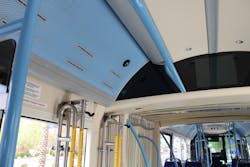When an agency is faced with a large scale event that has the potential to disrupt the safety and comfort of passengers the ways that agencies respond vary from one another. Dallas Area Rapid Transit (DART) operates as a government entity, as opposed to a city agency, DART has its own police department that is able to provide support to other jurisdictions in the area.
Providing support during weather or critical events in cities
As DART provides support to other emergency services it is often called in to assist in a variety of different events.
“The type of support that we provide or the type of involvement is completely situational. The probably more frequent examples of critical incidents are like fires in apartment buildings where we would provide support by sending buses over for cooling or warming stations for folks that have been evicted because of the fire. Or as rest areas for firefighters,” said Morgan Lyons, vice president, external relations, DART.
Lyons explained that the city jurisdictions know when DART is available and that the agency is willing to assist when they are contacted for assistance. In such situations DART works at doing what it does best, moving people. In situations like a fire, DART lets firefighters do what they do best and evacuate the building and DART works to provide a safe space for those who have been displaced.
A recent event that threw Texas into an emergency situation was Hurricane Harvey.
“We provided a lot of bus service as part of the evacuation support for Harvey,” said Lyons. “There were evacuees that needed to be dispersed to different facilities in the North Texas area. We provided some special service to children with special needs. These families had been evacuated from Houston. Again it’s important in a situation for us to concentrate on the things that we do well and work with the local jurisdictions responding to their needs.”
Deploying technology as an aid
The Regional Transportation Commission of Southern Nevada (RTC) switched to Safety Vision cameras around four years ago on its fixed route and paratransit vehicles. Since that implementation they have further developed that technology and how it can be used.
“We had an incident where a guy had barricaded himself on a bus with a gun. The police wanted to see what was going on inside the bus. Because of tinted windows and we had advertising over the windows of the bus, they had a hard time seeing in from the side of the bus. They could see from the front, but not the side. So we started looking for ways to get real-time access, and what we were able to do very inexpensively is connect our DVR to the router so that we can have access to an internet for those vehicles,” said Carl Scarbrough, RTC director of transit advertising, amenities & technical equipment.
The shift makes it easier to successfully respond to threats.
“What we’ve done is we’ve provided access to these cameras to law enforcement. The driver will be the one to report an incident. Through the dispatch they can contact the law enforcement agency and then they can then use the cameras to decide how to respond,” explained Scarbrough. “For drivers it’s a panic button and theoretically they could just go look at the camera and see if there is something going on or if the driver hit it inadvertently.”
The cameras also have audio access, which gives law enforcement another tool when there is a security situation.
“For law enforcement I think this technology is critical. If you have somebody on there with a gun, is he alone or are other there people? It’s just the kind of stuff that before you go on a bus to remove somebody with a gun that you want to know before you go on there. I think that it is going to contribute significantly to police officer safety, which is very important,” said Scarbrough. “We’ve always had cameras and we’ve always let our riders know that they are under surveillance so I don’t think that part really changes, but I think it will do a lot for law enforcements. Fortunately we haven’t had a lot of these situations, but in the world today you have to be prepared.”
When looking at which cameras to utilize RTC already had a significant investment in Safety Vision.
“There is a number of companies out there that have this live look capability,” said Scarbrough. “So rather than spending millions of dollars to re-camera our whole fleet we worked with Safety Vision.”
The transition to allowing for a live look into RTC’s vehicles did face a challenge.
“The most difficult challenge was resetting the mobile configurations on the mobile routers. Right now I think that we have a handful that we haven’t done. It is only on the fixed-route side, not the paratransit side,” said Scarbrough. “We are looking at adding a cellular based driver dispatch system and once we do that we will looking to add those system.”
Response towards and active shooter
“In the case of active shooters our police offers go through the same active shooter training that all Texas police officers go through. Ours are police officers, they’re not security guards. They’re regular police officers. That’s significate because in an active shooting incident, we’ve experienced more than one, but most notable one was July 7, 2016,” said Lyons. “Our officers were able to be engaged immediately because they’d had the same training, protocells and practices as other police departments.”
“In the July 2016 shooting where we were in active passenger service when it happened. The first shots were a block from our station and two blocks from our headquarters. We had bus operators there. I think the main thing that we did was work with the operators to make sure that they were safe and that their customers were safe,” explained Lyons. “After it was over we certainly offered them any critical incident counseling as we did for most everyone else to be sure they were okay. Fortunately those are pretty rare experiences. It is more common for us to have other critical incidents. The first priority is always safety, making sure the operator is safe and that the customers are safe. That could be securing them in place or finding the best way out of there.”
Lyons explained that DART has experienced a more common scenario when it comes to active shooters. “Where there is an active shooter or a report of an active shooter near our facilities. That has happened at the Dallas Police headquarters on a couple of different occasions and a community college in one of our service area cities. (In these situations) the city police department will take the lead. One of the things they will direct us to do is to stop service in that area. In case that guy is trying to get away, but more important is to keep from bringing more people and new potential targets into that location. Our officers will offer support if the police have to operate in and around our equipment, such as our light rail vehicles.”
In a situation like an active shooter the operators are alerted through dispatch. DART also has an active operations communication program that is responsible for customer communications. Where there is an event like an active shooter, riders are alerted via text or email. Information is also posted on DART’s social media accounts.
Training for successful responses
Training plays a big part in assisting other jurisdictions. DART conducts frequent exercises with a number of different scenarios; including active shooters, looking for explosive devices and terrorist threats. These exercises often take place in the field and a number of DART operators are brought in. The operators prepare with a lot of training on their side as well, including re-training.
“To support those things we do training exercises with other police departments. Other jurisdictions have some familiarity with our equipment. We have Dallas SWAT teams in our rail yards so they know the ins-and-outs of our trains and our buses, the proper way to board them to do a search or potentially engage someone who is making a threat,” said Lyons.



